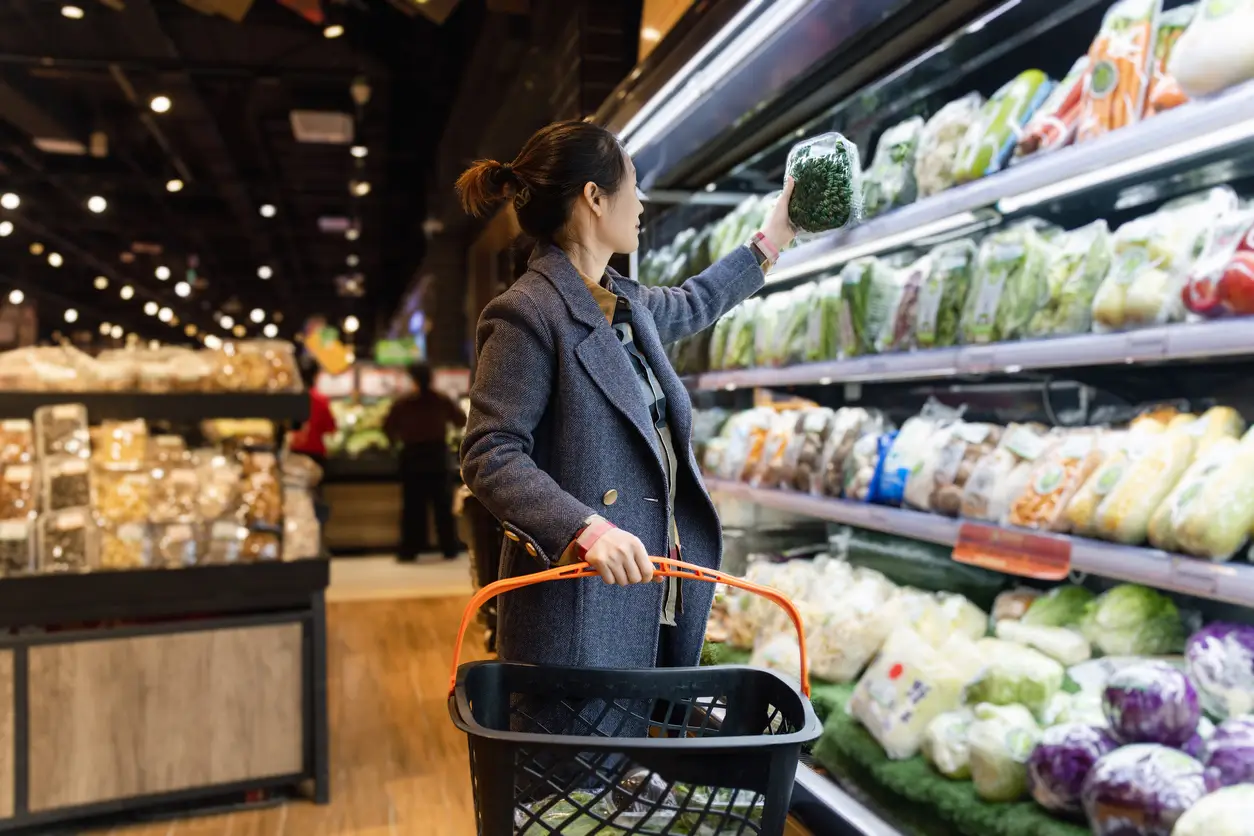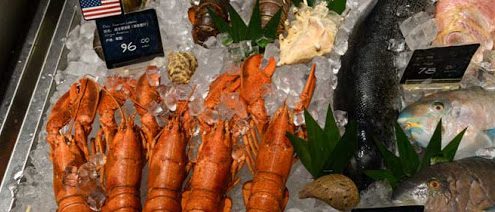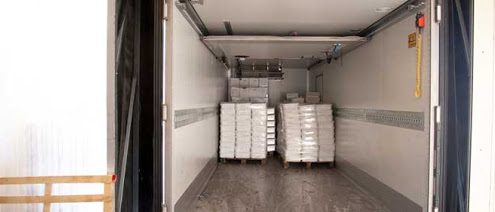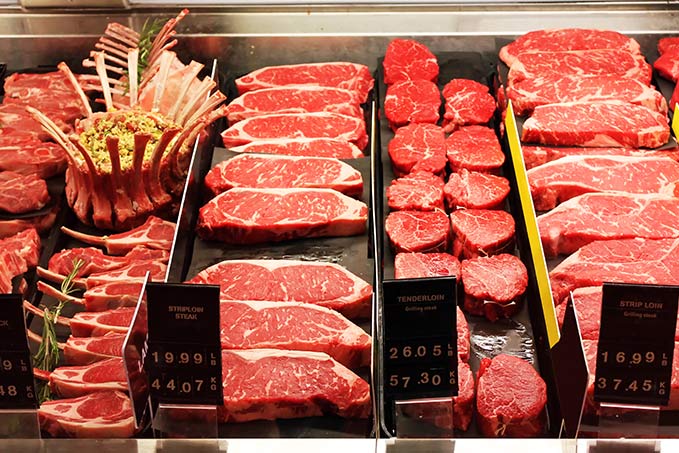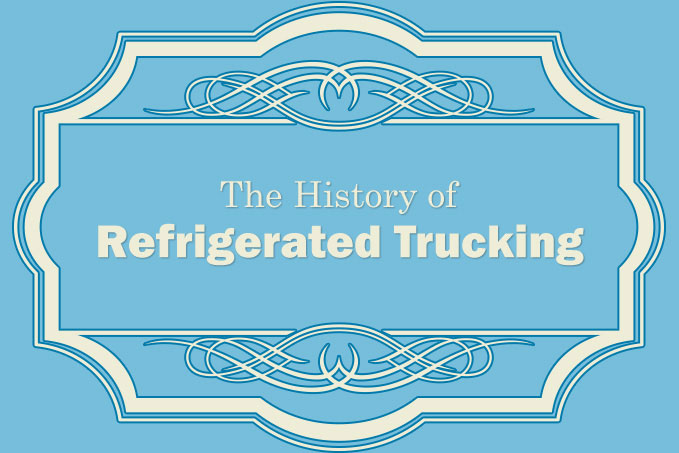Ice cream, TV dinners, popsicles, flowers, pharmaceuticals and more. How do you think all of that gets to a grocery store near you in the United States or anywhere else? Or how do you make sure all of that cold freight makes it to those locations safely and maintains that constant temperature. That’s where cold chain logistics comes in! Follow us down the frozen path to find out everything you need to know about cold chain logistics.
So what is cold chain logistics? Cold chain logistics, also commonly referred to as cool chain logistics or chill chain logistics, is a temperature controlled supply chain. In short, it’s a transportation chain that maintains freight at an agreed upon temperature throughout the logistics process.
For cold chain products, that includes a desired low-temperature range for everything from storage, distribution, equipment being used and logistics transportation all the way to the destination point. So, what is temperature sensitive freight? What is drayage? Think shipping fresh produce. It’s basically any freight that needs to adhere to cold chain logistics procedures.
Understanding the Cold Chain Process
Understanding the cold chain process is half the battle for your refrigerated goods. Maintaining optimal temperatures of refrigeration, or, maintaining freezing temperatures for frozen foods that must remain in their solid states, is the most important part of the cold chain process
If you don’t maintain refrigerated temperatures that customers demand, that product is considered unusable.
Why do we need to keep certain foods and products cold? It may seem simple but it’s also a basic part of the cold chain process we have to understand. In short, low temperatures prevent sensitive products from altering their state and reducing their shelf life. The two ways to preserve food and keep it cold are:
- Freezing (for long-term preservation)
- Refrigeration (used to keep a product’s shelf life from deteriorating in the short term, which is usually days for food and weeks for other products like pharmaceuticals)
Why is it Called a Cold Chain?
What’s the “chain” in cold chain, you might be asking. That’s because there are several pieces of the puzzle, or links in the chain, to get refrigerated products from door to door in real time. If the temperature drops during any part of the chain process the shelf life, or quality of that product diminishes and could be thrown away. This results in money losses for both the shipper and the cold chain companies they do business with. A successful cold chain keeps a product within mandated temperature ranges from start to finish!
What are the Links in the Cold Chain?
Links in the cold chain logistics process include:
- Refrigerated warehouses located in refrigerated production areas
- Refrigerated transportation
- Regular refrigerated warehouses
- Commercial refrigerated warehouses
- Local refrigerated transportation
- Refrigerated equipment at both retailer and wholesaler destination points
What are the Cold Chain Quality Standards for Refrigerated Production?
Did you know that the International Trade Administration estimates approximately $750 billion in cold chain product losses per year? To combat these losses, cold chain quality standards for refrigerated production are very important.
What are Quality Standards?
To begin with, quality standards in the cold chain industry are the overall guidelines for high-quality shipping. They basically set out the expectations your cold chain provider must follow. These requirements include:
- Shipping speed
- Guidelines for temperature
- Compliance regulations
Who Sets the Quality Standards?
The Food and Drug Administration (FDA) set your quality control standards for food shipping. Other standards that logistics providers must follow come from:
- U.S. Customs
- The International Air Transport Association (IATA)
- The Department of Transportation
- The Transportation Security Administration (TSA)
All of these agencies cover shipping procedures and review documents to help ensure the product safety of your cold chain logistics shipments.
How is Quality of Cold Food Measured?
A gas chromatography procedure can be performed to check the quality of your refrigerated food to make sure it met your standards throughout the delivery process. The gas chromatography analysis looks at food compounds that make our taste buds sing to make sure they are safe and intact. This means the food was kept at safe temperatures during the entire cold chain delivery.
Thermometers in intermodal trucks, reefers and storage facilities also keep track of any temperature fluctuations to ensure consistent cold temperatures during the journey.
Cold chain logistics companies that adhere to all regulations and testing procedures ensure your products arrive fresh and the way you expect. You will also avoid delays and testing when companies strive to meet all quality standards. In the end, following these procedures is best for your customers, which will always receive the refrigerated care your products deserve when they make it to their house.
Industries Using the Cold Supply Chain
The following cold chain products are very popular:
- Fruits and vegetables
- All fresh foods
- Floral market
- Dairy products
- How to transport ice cream and other confectionary treats
- Pharma products
- Meat market
- Seafood market
Cold Chain Pharma Industry is On the Rise
As we pointed out above, food isn’t the only big player in the cold chain logistics market. Pharmaceuticals is a big-time player in the cold chain industry. If many medicines reach a certain temperature that’s listed above their “safe range,” they become less effective and/or can jeopardize the health of a patient. That’s why the regulations are so tight for the pharma industry.
Different Forms of Cold Chain Logistics Transportation
While intermodal trucking for cold chain logistics is by far the most prevalent form of chill chain transportation, it’s not the only method of transport for refrigerated goods.
Air Transportation
Air transportation for perishable food is the least economical form of transportation by far. It is needed, though, for foods with short shelf lives that need to arrive quickly to keep it fresh for consumers. A large port of the air freight cold logistics process, almost 50 percent, involves storing the cold freight at the airport in coolers and being loaded on and off the refrigerated planes. It’s imperative that food does not stay on plane tarmacs long to avoid rises in temperature.
Sea Transportation
Sea transportation for refrigerated freight is by far the slowest form of transportation available. However, it’s a much more economical form of transportation. It’s not near as practical for perishable food for that reason. When vessel refrigerated freight transportation has to be done, it’s typically made for very important shelf life foods such as vegetables, fruits, fish, dairy products and meat that’s grown and produced far from home. The food sits in specialized refrigerated containers in boats specializing in refrigeration purposes. Cold air actually flows up through the floor grates and then makes its way around the refrigerated pallets before returning to the ceiling where the cool air is recirculated.
Rail Transportation
Rail freight transportation is used for long distances that take more than two days typically by intermodal trucks. There are three types of train cars that can be used for these purposes:
- Ice-cooled cars
- Insulated cars
- Ice-cooled cars
Rail transportation is not as convenient or fast as the other forms. However high-speed rail transport for perishable goods is still in the works for refrigerated freight.
Intermodal Transportation
All three of the above cold freight transportation methods above can combine to form an intermodal transportation network for your cold chain shipments. They are all connected to their own unique sources of power to keep your shipments cool and at the constant temperature-controlled degree range that you request.
- Cold chain freight by rail is connected to external power supplies, typically by a generator.
- Temperature sensitive freight on vessels is connected to the ship’s main power supply to keep your goods cold.
- Shipments via air transportation have the technology and power supply available to keep shipments chilled.
Trends in Cold Chain Logistics
The cold chain logistics industry is always changing! And the supply chain for popular refrigerated and frozen foods is always rotating. When consumers change their habits and companies adapt to meet growing needs, the management system of a cold chain logistics operation must adapt too. Some trends in cold chain logistics include:
Improving Speed
As consumer demand climbs, so does the speed in which refrigerated and frozen products must move on the cold chain logistics chain.
Improving Visibility
These days, customers want to watch their cold chain products in every facet of the logistics process, to ensure there is no “weak link” in the chain.
Outsourcing is King
Food suppliers always want to consolidate their business reach. Always look for partners willing to handle logistics and work around your business and not the other way around.
Utilize Analytics
In this day and age, if you’re not leveraging data analytics to see how your cold chain products are doing and how they can be enhanced on the chain, you are missing out on some great research.
Pay Attention to the Little Things
The more particular a product’s temperature is, the more important it is for a cold chain logistics provider to make sure they follow that product closely in every part of their supply chain.
Think Globally
The consumer market is demanding products on the other side of the pond. Always consider your options for a cold chain logistics provider that can handle things on the ground and overseas.
Remember Regulation Increases
With all this demand for food comes some downfalls. Increased cold chain deliveries means an increase in food safety regulations, particularly for refrigeration standards.
An example of that is the pharmaceuticals market. Years ago, pharmaceuticals only had to stay at the mandated temperature in storage facilities. Many pharmaceuticals now require constant temperature mandates for door to door delivery.
Rein in Costs to Save Money
Many cold chain logistics companies strive to control costs while helping customers achieve cold chain constant temperature satisfaction. An example of that is using better truck insulation to hold in the temperature while saving money on truck energy costs.
Improved Packages
Packages with better insulation material are superior for logistics companies shipping food and pharmaceuticals.
Maintaining Multiple Temperature Zones
To counteract the rising demand of cold chain products that come with consumer demand, many providers now offer different temperature zones that can be monitored by the driver and/or remotely.
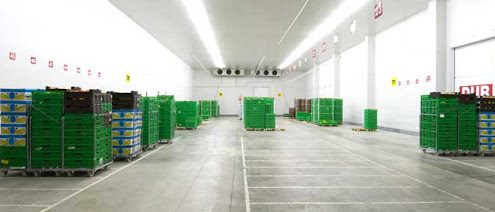
Cold Chain Logistics Technology You Need to Know
Cold chain logistics and technology go hand in hand these days. Technology is vital for both sanitary and safety delivery of items that are moved with temperature instructions. Examples of cold chain logistics technology include:
Data Loggers
Data loggers that monitor cold chain freight and most importantly, monitor the temperature of goods and set off alarms if there’s an issue.
Pallet Covers
Covers that can shield and protect cold chain goods during transport.
Tracking Devices
Real time GPS technology that keep tabs on refrigerated freight at all times.
Bar Code Tracking
Bar code inventory tracking keeps track of all items.
Trailer Technology is Important
Trailer technology includes:
- Insulated containers
- Proper reefer units (reefer trucks are refrigerated trailer beds attached to semi-trucks to move your cold freight)
- Good venting of chutes for air distributions
- Top of the line trailer equipment
- Emission compliant trailers to save on costs
Human Technology is Important
Training humans is just as important for cold chain logistics provider as adding technology! This type of training includes:
- Personnel and driver training
- Continuous technology update training
- Proper loading technology training
- Constant educational update training
You Can Avoid Rejected Cold Freight Shipments
To avoid rejected cold shipments, know that cold chain logistics companies are always doing the following:
- The FDA’s Food Safety Modernization Act enforces strict food safety protection legal guidelines
- Companies must know consumers demand quality refrigerated cargo
- Monitoring and keeping a watch over complex and expensive refrigeration devices
- Watching the cost of doing business to save money for customers
If refrigerated freight is delivered at the incorrect temperature, it costs companies money. Companies that handle refrigerated goods avoid that at all costs because:
- Spoiled cargo costs customers’ money
- The shipment must be thrown out, which costs the carrier money.
- If insurance pays a claim, the provider faces an increase in coverage rates for years
How to Avoid Risks with Refrigerated Loads
Refrigerated freight companies avoid risks by doing the following:
- Update refrigerated equipment: Companies always monitor equipment and foresee challenges or potential upgrades ahead of the curve.
- Install dataloggers that monitor temperatures.
- Intermodal truck driver training is important: Companies that realize consistent truck driver training is important for business stand out among the rest.
- Paying insurance premiums: Insurance policies with appropriate coverages ensure your freight is protected no matter what might occur in the course of a delivery. Companies avoid paying claims at all costs and will work with customers to address any concerns as they arise.
What if a Refrigerated Load Becomes Warm?
Sometimes things go wrong. If a refrigerated load becomes too warm because of a refrigerated malfunction or a delay in loading time, it won’t be accepted at its point of destination. Refrigerated freight companies work to:
Avoid Temperature Increases
Loading and unloading time is crucial to avoid temperature increases for refrigerated goods. Remember that refrigerated trailers are designed to hold a temperature of the goods.
Keep Equipment Running Seamlessly
The technology we have in today’s world allows intermodal companies to monitor their equipment closely. Avoiding refrigeration failure in trailers is crucial to a company’s success and the safe arrival of your refrigerated goods. Alarms, codes and notifications allow companies to fix any problems as they arise to keep their supply chain link humming along.
Detect Errors
Truck drivers have control over refrigeration reefers they haul and strive to keep your freight at the temperature you request from start to finish. There is a strong emphasis on driver training to keep your freight safe. Alerts are in use to notify truck drivers of any looming problems with refrigerated products.
Provide Documented Proof
Truck drivers document everything. With today’s technology offerings, companies have opportunities to make sure everything is monitored and documented using technology offerings that show you where your refrigerated freight is during the process.
Complying with Regulations
The Food Safety Modernization Act ensures the safety of refrigerated food from coast to coast is intact and temperature is maintained throughout a trip. Intermodal truck drivers monitor temperature control guidelines to deliver frozen and refrigerated freight on time.
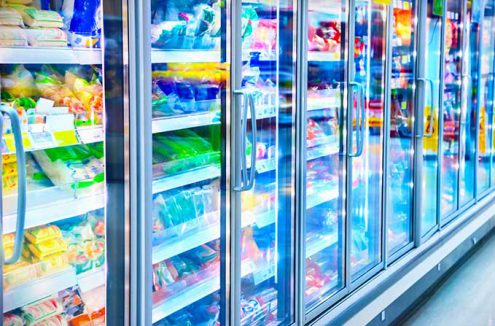
Cold Chain Refrigerated Warehouses
Refrigerated warehouses are a large dynamic to the cold chain logistics process. Also known as cold storage, warehouses are no longer the simple pallet in and out operations. The cold storage warehouses are adapting to become flexible to accommodate more fresh food shipments that consumers want delivered to their door.
Products that require cold storage or a temperature controlled solution include:
- Perishable food (fruits, vegetables, meat, seafood and dairy)
- Perishable nutrients
- Plants and flowers
- Pharmaceuticals
- Certain types of artwork
What are the Types of Cold Storage?
Refrigerated Containers
This is the basic option for refrigerated freight. This cold storage option is easily the most cost-effective and flexible option because there are also mobile refrigerated container options available.
Chillers and Blast Freezers
If you need a quick alternative to keep something cold before transport, a chiller, or blast freezer, gets the job done. These are also popular for food being shipped to restaurants and catering companies. Restaurants and caterers also keep chillers on site in their kitchens.
Cold Storage for Plants
Attached cold storage for plants is an excellent option for those looking to keep plants stored in optimal cool locations until it’s time for shipping.
Cold Rooms
Does this really need a definition? These are larger rooms that keep things cold during storage. It’s as simple as that.
Pharmaceutical Cold Storage
Research institutes and hospitals need cold storage units that are catered to the needs of their cold storage pharmaceuticals. These storage locations can handle pharmas, vaccines, blood and other biomedical needs.
Dedicated Cold Storage Locations
If your cold freight doesn’t have any complex or individualized cold storage needs, a simple dedicated cold storage warehouse works for your freight.
How Cold Chain Warehouses Reduce Costs to Save You Money
Did you know that ice cream and fruit like bananas have vast temperature control instructions? Those differences in temperature cost money. To avoid huge costs, cold chain warehouses perform the following money-saving techniques:
- Build small warehouse footprints that hold colder temperatures.
- Dropping cubic space for the same amount of storage is a huge perk.
- Smaller roof surfaces, which lessens the chance for cold air escaping through the roof.
- Reduction of employees in automated freezer warehouses, which keeps the cold storage spaces cooler and saves on labor costs.
- Reduction in defrosting procedures to just once per day, which saves on energy costs.
- Cold chain automated warehouses don’t require manually operated forklifts, which means there’s less labor and damage to the interior.
- Unlike traditional warehouses, cold storage facilities don’t need employees on the floor or to fix technology issues on-site.
- Safety issues on-site are virtually non-existent.
- Inventory accuracy is always spot on.
- Physical inventory counting isn’t needed, which reduces operational costs.
- Order accuracy at automated warehouses significantly receives very good scores.
- Fulfillment rates always hover at close to 100 percent.
- Inventory controlled by computers assures product freshness and reduces expiration issues.
- Refrigerated fright labeled as “quarantined” is locked electronically.
- Service reputation with cold chain logistics customers is excellent.
Cold Chain Logistics Spending
Just how fast is the cold chain logistics industry growing. Take a look at some mind-boggling cold chain logistics spending numbers:
- In 2017, more than $18 billion in logistics revenue is credited to the refrigerated food and grocery market.
- More than $17 billion was generated from the healthcare and pharmaceutical market.
- Pharmaceuticals is a $15 billion market, according to Pharmaceutical Commerce
Cold Chain Logistics Market Size
The global cold chain logistics market size is estimated to reach $447.5 billion by 2025, according to Grand View Research Inc. To keep up with consumer demand, there will continue to be technology enhancements in everything from packing, processing and cold storage procedures.
The Future of the Cold Chain Industry
In the cold chain industry, things freeze fast and change fast! Today’s consumers demand on-time delivery, real-time visibility and the latest in temperature control technology. It’s also interesting to note that millennials demand more fresh refrigerated food and are shying away from more shelf life type food that generations in the past demanded. Today’s consumers demand:
- Freshly prepared food
- Locally sourced fresh food
- Fresh meal kits
- Fresh food delivered to their door
All of this means producers of food and manufacturers are altering what they offer. For cold chain logistics providers, this means keeping up with the increasing demand of fresh refrigerated deliveries.
Are You Looking for Some Help?
If you are asking the following questions, you should contact ABCO today:
- How do I change my process to meet the growing demands of customers?
- How can I extend the shelf life of my product?
- Can I handle cold chain logistics alone?
- How do I avoid products spoiling?
- Can I monitor my refrigerated products in transit?
- Can I monitor how a driver treats my refrigerated good?
- Am I absolutely certain I am compliant with cold chain logistics rules and regulations?
- Can I make sure my cold chain products are free of diseases and Mother Nature issues?
- How do I make the most efficient use of transportation uses for my products?
- What’s the best way to load my refrigerated products while keeping them cold?
- How do I avoid rapid temperature changes in my refrigerated products?
- Are there tools I can use to monitor product temperature conditions?
ABCO Puts Customers First
Transportation companies like ABCO can tackle all of your intermodal trucking needs. If you’re looking for a company that can transport all your temperature-sensitive freight, ABCO makes customers their No. 1 priority. ABCO Transportation specializes in temperature-sensitive freight delivery nationwide. Our business allows us to provide the best and highest quality service offering that the industry provides. Intermodal transportation solutions help you meet your company’s supply chain needs, whether it’s shipping freight by truck, rail or water! To learn more about our service, contact us today!
